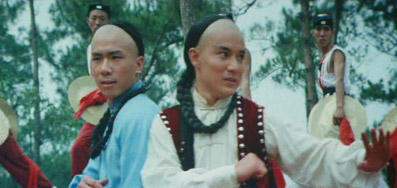|
You
don't have to be a devotee of martial arts cinema to work
out that The Young Hero of Shaolin 2 is
a sequel to – go on, take a guess – The
Young Hero of Shaolin, a rarely seen but average
genre piece that fluffs a few opportunities to stand out
from the crowd, but remains memorable for its briskly staged
old school kung-fu and Busby Berkeley-esque formation fighting
sequences.
The
first film's hero Fong Sai-Yuk is back, once again with a
subtitled variation on his name, though at least the Fong
Sze Yu suggested here is couple of notches closer than the
Fung Hsuin-Yu of the first film. He's perfected the two-fingered
strike he developed in Part One and starts things off with
a demonstration of its power, a balancing act that echoes
the one employed by one of Fong's former masters to an equally enthralled gathering of students
in the previous film. It's
a weapon he's going to need. Out to get him is a local mobster known
as Dragon Head, and Commissioner
Chang Bill, a fighter looking for revenge for the death
of his brother at Sai-Yuk's hands. Fortunate, then, that Sai-Yuk teams up with
former school friend Wu Wai-Kim and his sister, both formidable
fighters in their own right.

Anyone familiar with Part 1 will soon spot the changes
here. Gone are the extended Wushu demonstrations and stumbling
attempts at comedy, while the pace and action quota have
both been noticeably increased. Barely five minutes pass
without someone hitting someone else – in some cases the
build-up to battle is excluded completely and we arrive
on the scene with fists and feet already flying. Early fights
are brief and staged primarily to establish who is aligned
with and against whom, but once Wai-Kim's sister has been
kidnapped by Dragon Head and his boys, the narrative simplifies
and the battles expand to epic length. The longest of these
involves the return of the memorable formation work from
the first film, although the decision to considerably speed
up the frame rate gives the spectacular aerial shots an unintentionally
slapstick edge.
Speed
and efficiency are the martial arts watchwords here, although
occasionally inventiveness also gets a look in, the fight
involving coloured cloth and a practice session with courtship
overtones being particularly enjoyable. But there is a trade-off
here, with the constantly busy pace maintained at the expense
of character depth and development. If you've seen the first
film then you should have some investment in Sai-Yuk already,
but martial artist Shi Bao Hua, cheerfully likeable though
he is, lacks the easy charisma, star quality and showstopper
choreography of a Jackie Chan or Jet Li or Stephen Chow.
There's nothing wrong with the fights here, which are consistently
energetic in the old school tradition, but there's nothing
outstanding about them either, despite the increased use
of Sai-Yuk's deadly two-fingered strike and the sheer density
of the action in the formation encounter.
Young
Hero of Shaolin 2 is a definite step up on its
predecessor, and is lively enough to keep genre fans reasonably
happy, though never does quite enough to stand out from
a large and busy crowd. The generic pleasures are definitely
there and extend beyond the kung-fu to some amusing translation
work and that old school martial arts cinema habit of hijacking
passages from Hollywood movie soundtracks, the most surprising
example here being the opening bars of Frontier Town
from Jerry Fielding's splendid score for The Outlaw
Josey Wales.
As
with Soulblade's release of The Young Hero of Shaolin,
the transfer here is framed 2.20:1 and lacking in anamorphic
enhancement. Initial impressions are otherwise quite good,
with the opening dust soon disappearing and colours nicely
rendered. This does tend to vary, though, with some intermittent
quality drops resulting in the weakening of the solid contrast
and black levels of the earlier scenes. This variance can
be on a shot-to-shot basis, suggesting more than one print
was sourced for the transfer. At it's best, though, it's
not at all bad.

Both
Cantonese and English mono dubs are on offer, with the Cantonese
considerably louder than the English track. There's a treble
bias here which adds a slight hiss to the dialogue, something
not evident on the more muffled English dub. The sync is
also out for a while on the English track, though it makes
better use of background sound – mountain wind, for example
– than its Cantonese cousin.
The
subtitles are once again located outside of the picture
area and will require a vertical shift on the picture if
you are to zoom in on widescreen TVs. The minor grammar
hiccups from the first film remain, but are less frequent.
English
Credits
Both the start (2:00) and end
(0:24) credits for the English language version, seriously
squeezed up and of fluffy quality.
Stills
Gallery (2:05)
A rolling slide show of FOH stills and posters for the Hong
Kong release, plus two video covers.
Chinese
Wushu Academy (1:03)
A rolling textual slide show outlining the Academy of the
title, plus some contact details if you're interested in
signing up. There's a lot of text on each page and you'll
probably have to pause to read it.
There
are also trailers for a truckload
of Souldblade and Dragon releases.
If
you enjoyed The Young Hero of Shaolin then
you should be well happy with the sequel, which is faster
paced and bristling with action, though it's unlikely to convert
the uninitiated and remains primarily one for the genre
fans. Soulblade's DVD again lacks that always preferred
anamorphic enhancement, but although the print is uneven
in quality, at its best it improves on its predecessor.
|